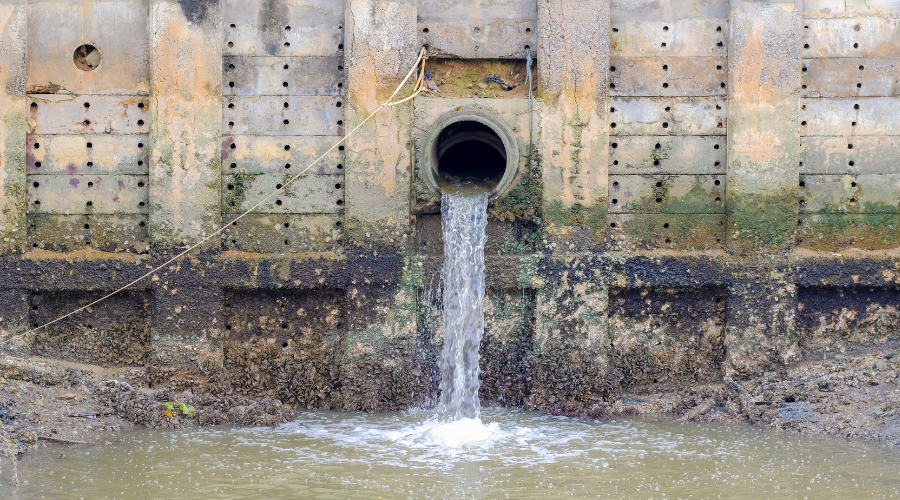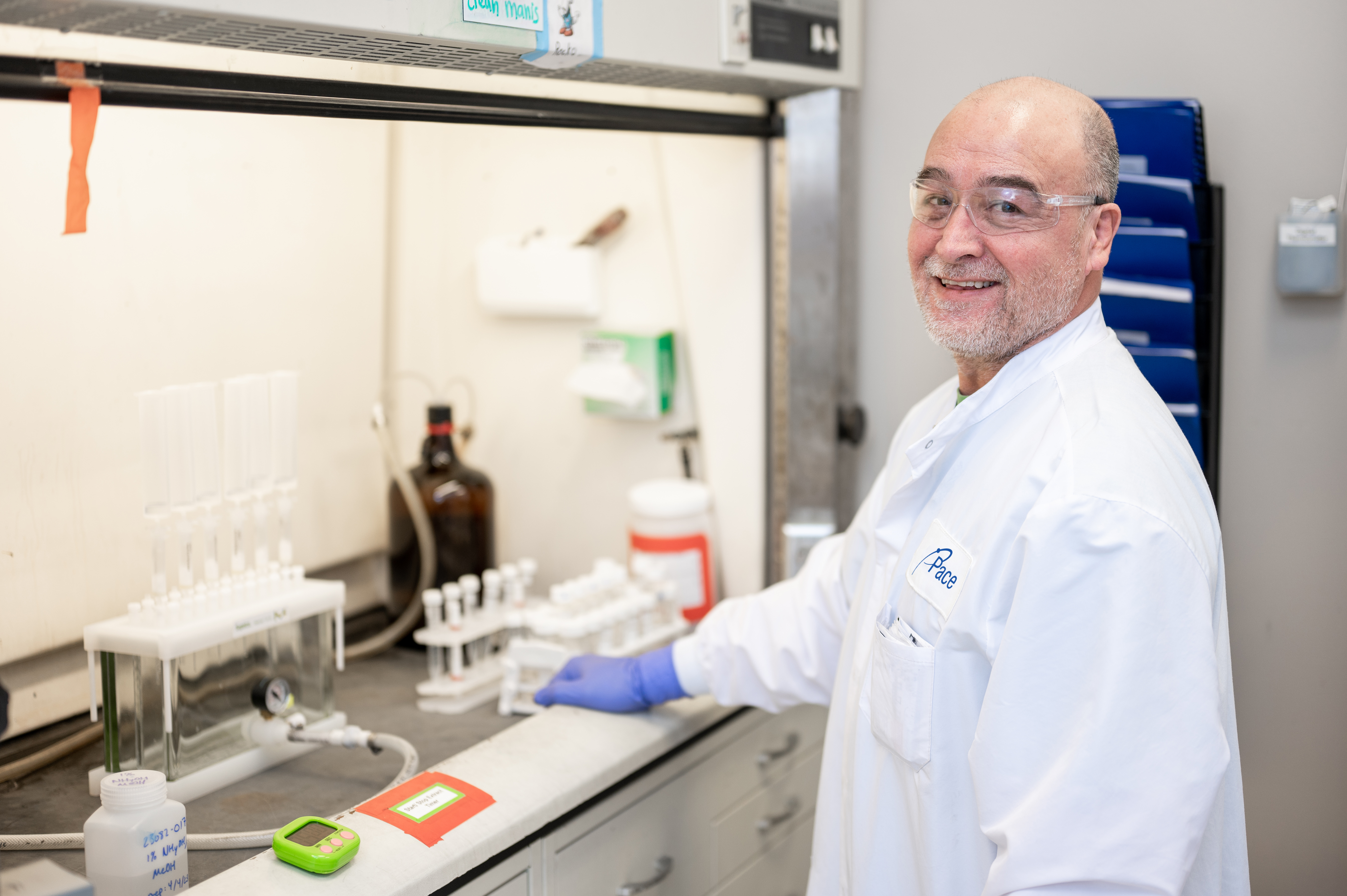Stormwater Runoff & the PFAS Problem

Per- and Polyfluoroalkyl Substances, otherwise known as PFAS, have become a frequent topic of discussion for water treatment and resource managers. This article examines the often-overlooked role stormwater runoff plays in propagating the PFAS problem.
What Are PFAS?
PFAS are a diverse group of synthetic compounds valued for their inherent properties, such as resistance to heat, water, and oil. For decades, they have been used to produce hundreds of industrial and consumer products such as carpeting, apparel, upholstery, food packaging, cosmetics, firefighting foams, and metal plating.
PFAS are bioaccumulative, meaning they can build up in the bloodstream and tissues of plants, animals, and people. Since at least the 80s, research has found links between PFOS and PFOA (two common PFAS chemicals) and health problems, such as chronic kidney disease, thyroid issues, certain types of cancers, etc. The U.S. EPA and others are conducting further research to determine the toxicity of other widely used PFAS.
Sources of PFAS in Stormwater
PFAS in stormwater can come from a variety of sources. Here are some of the most common.
Industrial runoff – Spills and improper disposal of PFAS at industrial sites can lead to PFAS in stormwater runoff. These sites include manufacturers of PFAS chemicals and industries that use PFAS in their products or production processes. Example industries include textiles, apparel, electronics, metal plating, and household goods manufacturers.
Landfills – With so many consumer and industrial products containing PFAS, contamination of landfills has become a significant concern. The EPA found elevated levels of PFAS in 95% of the landfills it studied in 2021. As rain, condensation, or liquid waste percolates through a landfill, it can leach PFAS from the solid and other liquid waste at the site. Ideally, landfills are equipped with functional leachate collection systems, but those that are not can leach PFAS into local soils and groundwater.
Construction and Demolition Sites – Construction materials (wiring, paints, carpeting, weatherproofing, etc.) frequently contain PFAS. When precipitation passes through an on-site (typically unlined) landfill or on-site stockpiles of materials, PFAS concentrations in stormwater may increase, as well as groundwater and surrounding soil of unlined landfills.
 Airports – PFAS are an important component of the aqueous film-forming foam (AFFF) used to fight aviation fires. Although some states now require fluorine-free foams (F3) in training exercises, AFFF is still required for use in an aviation emergency. Thus, stormwater runoff from airports can contain elevated levels of PFAS.
Airports – PFAS are an important component of the aqueous film-forming foam (AFFF) used to fight aviation fires. Although some states now require fluorine-free foams (F3) in training exercises, AFFF is still required for use in an aviation emergency. Thus, stormwater runoff from airports can contain elevated levels of PFAS.
Other Firefighting Sites – AFFF is also used to fight other chemical fires, so runoff from sites damaged by fire may contain PFAS. Even cleaning equipment used during an emergency or training can lead to an elevated concentration of PFAS in runoff.
Precipitation – Evidence suggests that PFAS can be transported and deposited through natural condensation. A Swedish study analyzed wet deposits from various sites around the world for the presence of PFOA, PFOS, and a combination of four PFAS (PFOA, PFNA, PFHxS, and PFOS). In both rural and urban areas in the U.S., concentrations were found to exceed the EPA’s health advisories for these compounds.
No Easy Answers for Managing PFAS in Runoff
After washing down the sewer grate, stormwater runoff typically takes one of two paths. In some instances, the Municipal Separate Sewer System (MS4) may route the runoff to a local wastewater facility for treatment. Unfortunately, traditional wastewater treatment does not effectively remove or destroy PFAS. In fact, these processes can transform PFAS precursors into terminal PFAS, such as PFOA.
In the U.S., the National Pollutant Discharge Elimination System (NPDES) monitors pollutants discharged into the environment, including from direct sources (untreated stormwater runoff and wastewater discharge) and indirect sources (treated wastewater). This program is administered by most states on behalf of EPA. The EPA has issued guidance to the states, but there is no universal requirement to include PFAS in NPDES permitting criteria as yet.
The EPA is intent on requiring the inclusion of PFAS in NPDES permits written for organic chemicals; plastics & synthetic fibers producers (OCPSF); metal finishing; electroplating; electric and electronic components; landfills; pulp, paper &paperboard; leather tanning & finishing; plastics molding & forming; textile mills; paint formulating; airports; and the POTWs that receive discharge from these industries. The EPA is also on record as stating that this list is not exhaustive, and others may be included.
Meanwhile, the EPA has allocated funding to help communities address PFAS and other emerging contaminants in wastewater and stormwater infrastructure. However, until a way is found to destroy these “forever chemicals,” there aren’t any easy answers as to what that infrastructure should look like. For instance, many communities are investing in Granular Activated Carbon (GAC) filtration systems. GAC filters appear to effectively filter PFAS out of water, but the contaminated filters still require disposal. Incineration was the preferred method for years, but its efficacy has come into question following studies that revealed elevated PFAS levels in soil, ash, groundwater, and air samples near incineration sites. Landfills are another common option, but as noted above, depositing PFAS in landfills cycles PFAS through the water treatment system and back into the environment.
What’s In Your Stormwater?
Even with no easy answers, well-informed decisions usually turn out to be the best decisions. In this case, the decision-making process should start with assessing the concentration of PFAS in your stormwater runoff. EPA drinking water methods 533 and 537.1 are ill-suited for analyzing liquid matrices with suspended solids and other interferants, so special methods are required.
.png?width=342&height=342&name=Stormwater%20(1).png) EPA Method 1633 – Method 1633 is designed to offer a standardized approach to measuring up to 40 PFAS in different environmental matrices, including wastewater, surface water, groundwater, soil, biosolids, sediment, landfill leachate, and biological tissues. Even before the method was finalized in January of 2024, it was recommended for NPDES permitting by the EPA. Going forward, Method 1633 will play a vital role in the EPA’s efforts to study, monitor, and regulate PFAS in nearly all matrices and regulatory programs except drinking water. This method will be adopted into SW-846 for the RCRA program and will soon be promulgated in 40 CFR Part 136.
EPA Method 1633 – Method 1633 is designed to offer a standardized approach to measuring up to 40 PFAS in different environmental matrices, including wastewater, surface water, groundwater, soil, biosolids, sediment, landfill leachate, and biological tissues. Even before the method was finalized in January of 2024, it was recommended for NPDES permitting by the EPA. Going forward, Method 1633 will play a vital role in the EPA’s efforts to study, monitor, and regulate PFAS in nearly all matrices and regulatory programs except drinking water. This method will be adopted into SW-846 for the RCRA program and will soon be promulgated in 40 CFR Part 136.
EPA Method 1621 – Method 1621 measures adsorbable organic fluorine (AOF) in non-potable water, including stormwater. High levels of AOF indicate that targeted testing by Method 1633 may be warranted. Method 1621, described by the EPA as a screening method, can detect organic fluorine concentrations in non-potable water from the many PFAS compounds not detectable by targeted methods such as EPA 1633.
ASTM D8421/EPA 8327 – ASTM D8421 is a PFAS method developed by the American Society for Testing and Materials (ASTM) to provide the industry with a fast, robust method for PFAS analyses in aqueous matrices. ASTM D8421 utilizes Liquid Chromatography/Tandem Mass Spectrometry (LC/MS/MS), with optional uses of Isotope Dilution (ID) to minimize the impacts of sample matrix interference on quantification and thus improve data quality. Technically similar to EPA 8327, either method can be cited.
ASTM D8421/EPA 8327 has several advantages over other methods. Turnaround time (TAT) is faster, and the method is often less expensive than other published methods that are more procedurally challenging. In addition, the method only requires a 15 mL sample, saving significant field collection time and shipping costs.
These advantages make ASTM D8421/EPA 8327 an attractive option for wastewater programs. Although the EPA recently finalized Methods 1633 and 1621, it may consider adding ASTM D8421 to 40 CFR Part 136 as an approved test method for NPDES permit holders.
Total Oxidizable Precursors (TOP Assay) – As noted earlier, PFAS precursors are a class of PFAS compounds that can degrade to terminal PFAS compounds under the right conditions, including traditional wastewater treatment processes. TOP Assay oxidizes PFAS precursors, most of which are compounds not currently measured by targeted techniques, converting them into their terminal PFAS compounds that can then be measured. The increase in PFAS measured after the TOP Assay oxidation relative to pre-oxidation levels is a gross estimate of the total concentration of PFAS precursors present in a sample.
Choosing the Right Method
Many variables need to be considered when choosing a test method for wastewater and stormwater analysis. NPDES permitting requirements in your state are at the top of that list. Sample characteristics, such as the level of total suspended solids (TSS), can also play a role. Budget and time constraints may as well. A qualified laboratory should be able to help you choose the right method for your project requirements.


